February 4, 2004
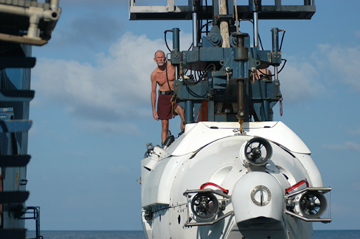
Ken Kenerson atop Alvin during the Wednesday launch.
Last night was another late night of Rabbit Cam work that yielded more pictures, magnetic data, and rock samples. Unlike the first camera tow, EPR Lava Flows scored 5 balls last night, while Fornari recovered only 3. The score is now 8-all, all hope is not lost since another box of balls was discovered onboard. Most of us spent today working up the data from yesterday's dive and last night's camera tow. The 'rock team' was busy processing the samples from the waxed corer balls, while many others sorted through navigation data, magnetics, and Imagenix sonar data.
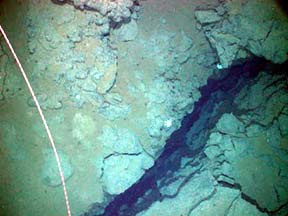
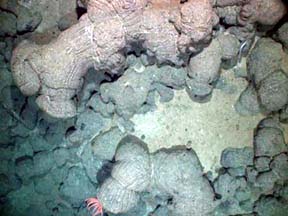
Photographs from last nights camera two. Both of these pictures were taken a few kilometers away from the ridge axis. The photo on the left shows a fissure with some nearby lavas that may have erupted from it. There are also two small galatheid crabs on the edge of the fissure suggesting some fluid may be coming out of the crack. The right photo is of a pile of pillow lavas associated with fissures that develop as the oceanic crust spreads away from the axis.
The video team was hard at work capturing still images from video footage collected during yesterday's Alvin dive #3961. This afternoon the science party gathered for a debriefing on yesterday's dive, and this evening many of us met to discuss the plans for upcoming dives and camera tows.
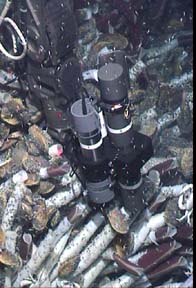
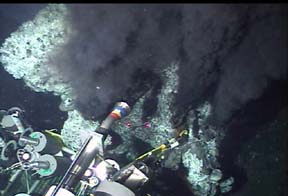
Photos taken during the first dive from Alvin. On the left, are intruments measuring the chemical characteristics of warm fluids frm TICA vent. On the right, the "ghostbuster" is measuring the chemistry of the black smoker at P vent.
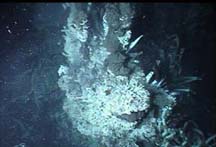
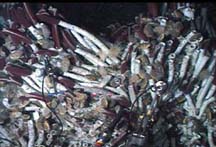
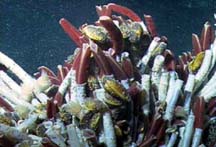
Various photos of the low and high temperature vents and animal communities around TICA vent. The middle photo shows two chemical sensors developed by Bill Seyfried and Kang Ding of U. Minnesota that were left in the vents to measure changes in fluid composition over extended time periods.
Each afternoon we have been meeting in the library to hear talks about the experiments and research each of the scientists are doing here on the East Pacific Rise. Yesterday, Yuri Rzhanov, from the University of New Hampshire gave a presentation on image processing and new computer methods of creating pictures of large areas of the seafloor by joining or mosaicking individual pictures. He will be making mosaics of some of the areas we study in detail.
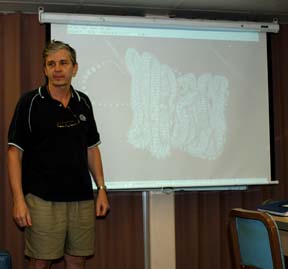
Yuri Rzhanov shows a mosaic of the seafloor that he created of a ~50x60m area in the Galapagos Rift near 86°W using individual deep-sea digital photos taken by Alvin in 2002.
Alvin was launched around 8:30 this morning with pilot Tony Tarantino and scientists Ken Sims and Maurice Tivey. Unfortunately, today's dive was cut short due to technical difficulties, and the team surfaced around 10:50 AM. The Alvin group is hard at work repairing the submersible and will get us back in the water as soon as possible. In the meantime, the Rabbit Cam is hopping its way along yet another camera tow transect. This will provide us with important information about areas of the seafloor were we are planning to dive in the next few days. The towcam pictures in conjunction with the sidescan images allow us to decide on a dive track before the dive which lets us use the precious time on the bottom more efficiently.
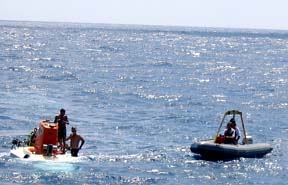
The Avon assists with Alvin recovery on Wednesday afternoon
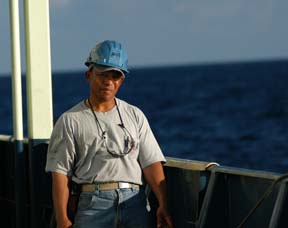
Jose Andrade, Ordinary Seaman, mans one of the tag lines to secure the Avon back aboard the Atlantis after Alvin is recovered.